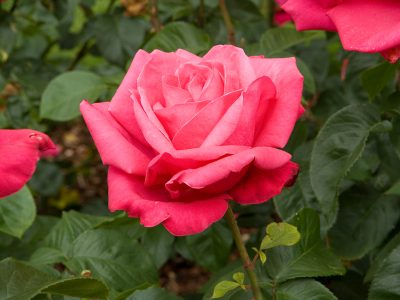By Barrie Anderson
Minnesota gardeners who cultivate roses in their landscapes are most likely keenly aware of pruning methods. It’s important to note there are three types of Roses that are commonly grown here in Minnesota, the hybrid Tea Rose, the shrub Rose (aka Floribunda roses), and the climbing Rose, all of which require slightly different pruning actions.
Climbing roses are fairly simple to prune. In very early spring climbing roses benefit from removal of dead or damaged canes. If there are older and less productive canes, those can be cut all the way down to the base. For summer pruning of climbers, deadhead the spent blossoms. If the climbing rose is a repeat bloomer, then after the first bloom of flowers, cut all the side branches back to leave just 2 or 3 buds. This will increase blooming for the rest of the season! Always, cut at a 45 degree angle to promote water running off the wound and avoid an opportunity for any fungi to set up house. Typically summer pruning on climbers is no longer performed after about mid-August.
Hybrid Tea roses require a bit more care, but are very much worth it. In early spring, after you’ve awakened them from their winter slumber, uncovered their blanket of straw, cut back by ½ the canes you desire to keep. Winter always kills a few rose canes, so be certain to remove those as well, all the way down to the base. Now, for summer pruning of Hybrid Teas, it’s imperative to deadhead the spent blossoms to promote further blooming. Keep in mind to always cut at an angle AWAY from the center of the plant just a ¼” above a bud that faces AWAY from the center of the plant. In other words, cut above a bud that’s facing outward and be certain to count down the stem to the next highest node with at least 5 leaflets. This is where the strongest bud will come in next. Cutting at an angle away from the center of the plant allows for water to runoff the wound. Also, buds facing outward will grow outward, hence, not clogging up the middle of the plant and preventing air and light from entering. Roses are susceptible to a plethora of fungi, so keeping the interior of the rose bush airy and light will do wonders to prohibit disease. Summer pruning should cease about mid-August.
Shrub roses are quite durable and typically repeat bloomers. The first round of pruning happens in April with the plant being cut back to 1/3 rd of their normal height. Always remember to cut at a 45 degree angle outward from the center of the plant. If the rose bush appears rather pekid in spring, it’s perfectly acceptable to cut it back to the ground as almost all shrub roses are grown on their own roots and will flourish from a total cut back every now and then. For summer pruning the same technique applies to shrub roses as the tea and climbing roses. Cut at an angle away from the center of the plant, about 1/4” above the next bud facing outward. This point on the plant is where the next set of strong buds most likely will be. Once again, summer deadheading/pruning should wind down about mid-August. By doing this, the gardener allows the plant to create rose hips which are beautiful specimens used in fall and winter décor!
Following the above methods will improve air flow, promote blooming and speed recovery from any sustained winter damage.
Happy pruning!

